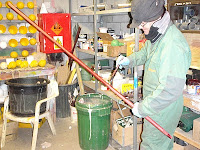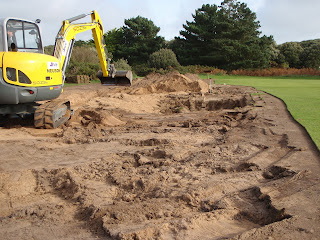The maintenance of machinery is an on-going requirement throughout the year but in the winter months thorough inspections and major overhauls are carried out to all plant and machinery. In the image above Gary and Matt are preparing cutting units for sharpening with our dedicated in-house cylinder grinding equipment.

Re-painting of golf course equipment such as bunker rakes, tee markers and hole cups is another on-going requirement. We use six different colours of tee marker on the course and these need to be kept in good condition.
In total we have more than 200 tee markers and with 54 hole cups and more than 50 rakes we are never short of something to paint!
We have many benches around the course most of which have been donated over the years by members or the families and friends of members who have passed. Each year they are removed from the course to be rubbed down and varnished to ensure they are kept in the best condition possible for as long as possible.
 Numerous other housekeeping tasks are attended to around the maintenance facility. The club invested heavily in the purpose built maintenance complex a number of years ago and we try to be diligent in our upkeep of the fantastic facility that we have. In the image above some of the block work from the yard has been lifted to remove tree roots.
Numerous other housekeeping tasks are attended to around the maintenance facility. The club invested heavily in the purpose built maintenance complex a number of years ago and we try to be diligent in our upkeep of the fantastic facility that we have. In the image above some of the block work from the yard has been lifted to remove tree roots. Of course numerous other tasks are carried out regularly which have not been featured here, some of which we will highlight in future posts















































